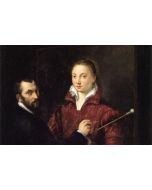The art of Byzantium
This course will be delivered online. See the ‘What is the course about?’ section in course details for more information.

- Course Code: VB661
- Dates: 02/05/24 - 06/06/24
- Time: 14:00 - 16:00
- Taught: Thu, Daytime
- Duration: 5 sessions (over 6 weeks)
- Location: Online
- Tutor: Anita Chowdry
Course Code: VB661
Duration: 5 sessions (over 6 weeks)
Please note: We offer a wide variety of financial support to make courses affordable. Just visit our online Help Centre for more information on a range of topics including fees, online learning and FAQs.
What is the course about?
Byzantium, or the Eastern Roman Empire, was officially founded in the 4th century CE. by Constantine I, who gave his name to the new Eastern capital Constantinople, built on the ancient city of Byzantium. It was the first Christian superpower, under which a unique visual culture was forged, lending its style to great works of architecture and design, as well as a wide variety of state- supported arts and crafts.
In this course we will study the influences of the cultures within the Empire that contributed to the visual flavor of Byzantine art, such as the craft traditions of Egypt and the Near East, superimposed upon the Hellenic and Roman roots of the Empire. We will also look at the impact of the arts of conquered Northern tribes that added to a rich creative synergy dedicated to the glory of the Eastern Orthodox Church and its Patriarchy.
There will be a focus on the creative explosion of the reign of Justinian I in the 6th century, the building and design of Hagia Sophia in Constantinople, his expansion into Ravenna, and the development of state-controlled craft industries in Italy, Syria and Egypt that supported his vision, such as glass, mosaic, gold and metalwork, lapidary-work, textiles and painting.
Tracing the subsequent development of later Byzantine arts, we will examine some of its influences on the arts of Italy and Europe, the Islamic Caliphates, and the Ottoman Empire under which Constantinople finally fell in 1453. Finally, we will explore the resonance of Byzantine art in the 19th century and beyond, interwoven with new aesthetics in painting, design, and book illustration.
This is a live online course. You will need:
- Internet connection. The classes work best with Chrome.
- A computer with microphone and camera is best (e.g. a PC/laptop/iMac/MacBook), or a tablet/iPad/smart phone/iPhone if you don't have a computer.
- Earphones/headphones/speakers.
We will contact you with joining instructions before your course starts.
What will we cover?
• The rise of Byzantine visual culture, and the influences that fed into it.
• Hagia Sophia, and achievements in architecture and design under Justinian I (527 – 565 CE)
• State controlled craft industries in the Near East.
• Textile industries under Byzantium.
• The influence of Byzantine art on other cultures.
What will I achieve?
By the end of this course you should be able to...
· List the diverse cultural influences that went into the development of Byzantine art and crafts.
· Describe the creation and impact of Justinian’s Hagia Sophia at Constantinople.
· Identify and describe 3 examples of Byzantine crafts.
· Discuss the wider impact and influence of Byzantine art on subsequent cultures.
What level is the course and do I need any particular skills?
This course is suitable for all levels.
You should be able to follow simple written and verbal instructions, demonstrations, hand-outs and health and safety information as well as basic functions of Zoom, specifically microphone and camera.
How will I be taught, and will there be any work outside the class?
You will be taught with slide presentations and group discussions. You will be supplied with weekly handouts on each topic, with summaries, pictures and resources. You will be given some reading and quizzes to consolidate your understanding of the subject.
Reading materials will be available online/digitally for download via a Google Classroom. You will be invited to join this Google Classroom within a week of the start of your course.
Are there any other costs? Is there anything I need to bring?
You might wish to bring a notebook and pencil. You might also wish to buy some of the books on any reading list given out in class, this being a matter of personal choice.
When I've finished, what course can I do next?
Arts of the Empire Builders: Timurids, Safavids and Mughals
Arts of the Golden Age of the Ottoman Empire.
Anita Chowdry is a London based visual artist, educator and researcher. Her particular interest is in the arts of the Islamic World and South Asia, and the materials and processes that went into them. She has an M.A. in Art and Science from Central Saint Martin’s UAL, and is currently engaged in the codicological study of a group of 15th Century Turcoman manuscripts at the Bodleian Library, Oxford. Anita has over 30 years’ experience teaching art and process to adults and professional groups, covering major institutions in the UK and abroad.
Please note: We reserve the right to change our tutors from those advertised. This happens rarely, but if it does, we are unable to refund fees due to this. Our tutors may have different teaching styles; however we guarantee a consistent quality of teaching in all our courses.
